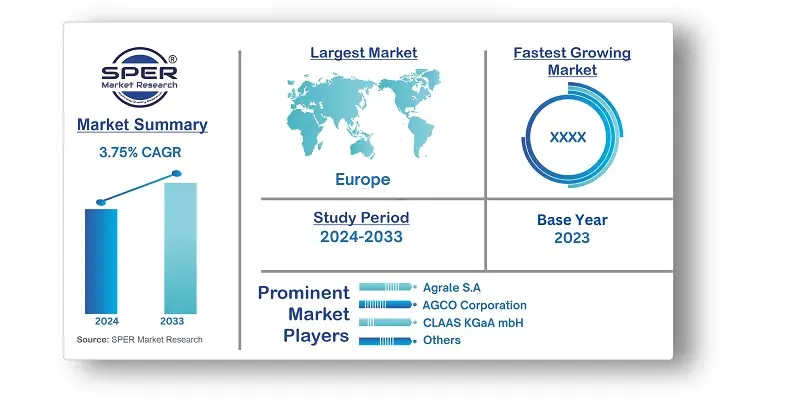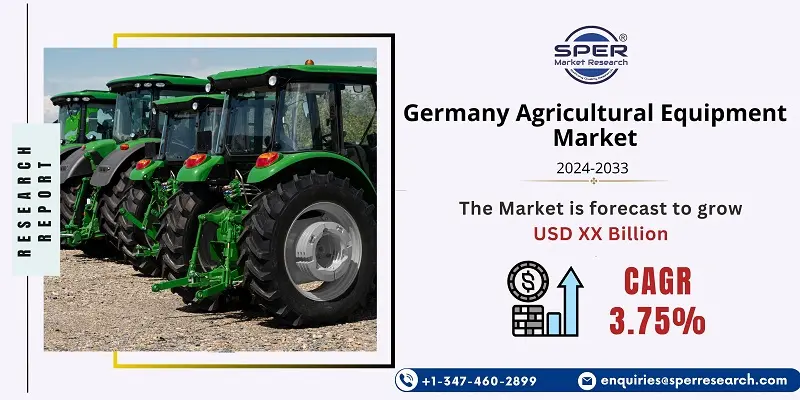
Germany Agricultural Equipment Market Growth, Size, Trends, Demand, Share and Future Outlook
Germany Agricultural Equipment Market Size- By Equipment Type, By Application Type- Regional Outlook, Competitive Strategies and Segment Forecast to 2033
| Published: Jul-2024 | Report ID: AGRI2429 | Pages: 1 - 107 | Formats*: |
| Category : Agriculture | |||
- In August 2022, AGCO introduced the most recent model in the Fendt 700 Vario series of tractors. It included an improved powertrain with VarioDrive gearbox and the Fendt iD low engine speed concept. The goal of this new generation is to increase customer productivity and efficiency.
- In June 2022, the CLAAS AXION 900 series of large tractors for contractors and large farms will be fitted as standard with the upgraded, continuously variable ZF Terramatic gearbox.


| Report Metric | Details |
| Market size available for years | 2020-2033 |
| Base year considered | 2023 |
| Forecast period | 2024-2033 |
| Segments covered | By Equipment Type, By Application Type |
| Regions covered | Eastern Region, Western Region, Southern Region, Northern Region |
| Companies Covered | Agrale S.A, AGCO Corporation, CLAAS KGaA mbH, Deere & Company, CNH Industrial N.V, Kubota Corporation, Mahindra & Mahindra Ltd, Yanmar Co. |
- Farmers and Agricultural Producers
- Agribusiness Companies
- Agricultural Cooperatives
- Agricultural Equipment Dealers and Distributors
- Government and Regulatory Bodies
- Research and Academic Institutions
- Agricultural Contractors
- Financial Institutions and Insurance Companies
| By Equipment Type: |
|
| By Application Type: |
|
- Germany Agricultural Equipment Market Size (FY’2024-FY’2033)
- Overview of Germany Agricultural Equipment Market
- Segmentation of Germany Agricultural Equipment Market by Equipment Type (Tractors, Planting Equipment, Tillage Equipment, Sprayer, Harvesting Equipment, Mowing Equipment, Others)
- Segmentation of Germany Agricultural Equipment Market by Application Type (Land Development and Seed Bed Preparation, Sowing and Planting, Plant Protection, Harvesting and Threshing, and Post Harvesting)
- Statistical Snap of Germany Agricultural Equipment Market
- Expansion Analysis of Germany Agricultural Equipment Market
- Problems and Obstacles in Germany Agricultural Equipment Market
- Competitive Landscape in the Germany Agricultural Equipment Market
- Impact of COVID-19 and Demonetization on Germany Agricultural Equipment Market
- Details on Current Investment in Germany Agricultural Equipment Market
- Competitive Analysis of Germany Agricultural Equipment Market
- Prominent Players in the Germany Agricultural Equipment Market
- SWOT Analysis of Germany Agricultural Equipment Market
- Germany Agricultural Equipment Market Future Outlook and Projections (FY’2024-FY’2033)
- Recommendations from Analyst
1.1. Scope of the report1.2. Market segment analysis
2.1. Research data source2.1.1. Secondary Data2.1.2. Primary Data2.1.3. SPER’s internal database2.1.4. Premium insight from KOL’s2.2. Market size estimation2.2.1. Top-down and Bottom-up approach2.3. Data triangulation
4.1. Driver, Restraint, Opportunity and Challenges analysis4.1.1. Drivers4.1.2. Restraints4.1.3. Opportunities4.1.4. Challenges4.2. COVID-19 Impacts of the Germany Agricultural Equipment Market.
5.1. SWOT Analysis5.1.1. Strengths5.1.2. Weaknesses5.1.3. Opportunities5.1.4. Threats5.2. PESTEL Analysis5.2.1. Political Landscape5.2.2. Economic Landscape5.2.3. Social Landscape5.2.4. Technological Landscape5.2.5. Environmental Landscape5.2.6. Legal Landscape5.3. PORTER’s Five Forces5.3.1. Bargaining power of suppliers5.3.2. Bargaining power of buyers5.3.3. Threat of Substitute5.3.4. Threat of new entrant5.3.5. Competitive rivalry5.4. Heat Map Analysis
6.1. Germany Agricultural Equipment Market Manufacturing Base Distribution, Sales Area, Product Type6.2. Mergers & Acquisitions, Partnerships, Product Launch, and Collaboration in Germany Agricultural Equipment Market
7.1. Germany Agricultural Equipment Market Size, Share and Forecast, By Equipment Type, 2020-20267.2. Germany Agricultural Equipment Market Size, Share and Forecast, By Equipment Type, 2027-20337.3. Tractors7.3.1. Horsepower7.3.2. Wheel-Drive7.4. Planting Equipment7.4.1. Seeder7.4.2. Planter7.4.3. Transplanter7.5. Tillage Equipment7.5.1. Plough7.5.2. Harrow7.5.3. Tiller7.6. Sprayer7.6.1. Field Crop Sprayers7.6.2. Orchard Sprayers7.7. Harvesting Equipment7.7.1. Combine Harvester7.7.2. Self-Propelled Forages7.8. Mowing Equipment7.8.1. Mower7.8.2. Windrower7.9. Others
8.1. Germany Agricultural Equipment Market Size, Share and Forecast, By Application Type, 2020-20268.2. Germany Agricultural Equipment Market Size, Share and Forecast, By Application Type, 2027-20338.3. Land Development and Seed Bed Preparation8.4. Sowing and Planting8.5. Plant Protection8.6. Harvesting and Threshing8.7. Post Harvesting
9.1. Germany Agricultural Equipment Market Size and Market Share
10.1. Germany Agricultural Equipment Market Size and Market Share By Region (2020-2026)10.2. Germany Agricultural Equipment Market Size and Market Share By Region (2027-2033)10.3. Eastern Region10.4. Western Region10.5. Southern Region10.6. Northern Region
11.1. Agrale S.A11.1.1. Company details11.1.2. Financial outlook11.1.3. Product summary11.1.4. Recent developments11.2. AGCO Corporation11.2.1. Company details11.2.2. Financial outlook11.2.3. Product summary11.2.4. Recent developments11.3. CLAAS KGaA mbH11.3.1. Company details11.3.2. Financial outlook11.3.3. Product summary11.3.4. Recent developments11.4. Deere & Company11.4.1. Company details11.4.2. Financial outlook11.4.3. Product summary11.4.4. Recent developments11.5. CNH Industrial N.V11.5.1. Company details11.5.2. Financial outlook11.5.3. Product summary11.5.4. Recent developments11.6. Kubota Corporation11.6.1. Company details11.6.2. Financial outlook11.6.3. Product summary11.6.4. Recent developments11.7. Mahindra & Mahindra Ltd11.7.1. Company details11.7.2. Financial outlook11.7.3. Product summary11.7.4. Recent developments11.8. Yanmar Co11.8.1. Company details11.8.2. Financial outlook11.8.3. Product summary11.8.4. Recent developments11.9. Others
SPER Market Research’s methodology uses great emphasis on primary research to ensure that the market intelligence insights are up to date, reliable and accurate. Primary interviews are done with players involved in each phase of a supply chain to analyze the market forecasting. The secondary research method is used to help you fully understand how the future markets and the spending patterns look likes.
The report is based on in-depth qualitative and quantitative analysis of the Product Market. The quantitative analysis involves the application of various projection and sampling techniques. The qualitative analysis involves primary interviews, surveys, and vendor briefings. The data gathered as a result of these processes are validated through experts opinion. Our research methodology entails an ideal mixture of primary and secondary initiatives.



Frequently Asked Questions About This Report
PLACE AN ORDER
Year End Discount
Sample Report
Pre-Purchase Inquiry
NEED CUSTOMIZATION?
Request CustomizationCALL OR EMAIL US
100% Secure Payment






Related Reports
Our Global Clients
Our data-driven insights have influenced the strategy of 200+ reputed companies across the globe.




















